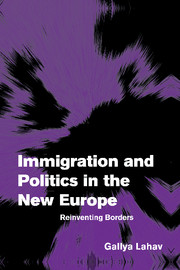Book contents
- Frontmatter
- Contents
- List of figures and tables
- Preface and acknowledgments
- 1 Introduction
- 2 Toward a people's Europe: an institutional analysis of immigration policy in the European Union
- 3 An attitudinal portrait of a people's Europe: a comparative overview of public opinion and elite preferences
- 4 Immigration politics and the new Europe: organizing competing interests
- 5 The “European factor”: institutional and psychological constraints on immigration attitudes
- 6 Conclusions: the construction of a European immigration regime?
- Appendices
- Bibliography
- Index
6 - Conclusions: the construction of a European immigration regime?
Published online by Cambridge University Press: 18 December 2009
- Frontmatter
- Contents
- List of figures and tables
- Preface and acknowledgments
- 1 Introduction
- 2 Toward a people's Europe: an institutional analysis of immigration policy in the European Union
- 3 An attitudinal portrait of a people's Europe: a comparative overview of public opinion and elite preferences
- 4 Immigration politics and the new Europe: organizing competing interests
- 5 The “European factor”: institutional and psychological constraints on immigration attitudes
- 6 Conclusions: the construction of a European immigration regime?
- Appendices
- Bibliography
- Index
Summary
Closing Act: The fate of a congressman from Youngstown [Ohio] depends on decisions taken in Brussels or Tokyo. The tradeoff for price stability in Hamburg may be unemployment in Harlem. In such predicaments, governments and politicians must choose some mix of two broad strategies: one nationalist, one internationalist. They may try to regain control over their own destiny by reerecting barriers. Or they may seek instead to cooperate in an effort to manage politically.
Robert Putnam and Nicholas Bayne, in Hanging Together (1987: 3)If the preceding analysis on immigration norms has proved anything, it is that efforts to create a common regime in Europe may take several forms. Nationalist and internationalist impulses within the European Union may be more compatible than traditional assumptions about cooperation have suggested. Too often, the policy discourse on globalization or European integration ignores the restrictive nature of cooperation that allows nations to remain protectionist – especially with regard to issues that are emblematic of their national sovereignty and identity. Perceptive immigration scholars have noted the trend toward restrictivism since the 1990s, yet the momentum toward Europeanization belies this phenomenon, and therefore the general point bears repeating. Increasingly, progress in European integration is accompanied by a reinvention of borders that can be understood only by examining the norms and attitudes that underpin immigration policy.
- Type
- Chapter
- Information
- Immigration and Politics in the New EuropeReinventing Borders, pp. 204 - 231Publisher: Cambridge University PressPrint publication year: 2004

